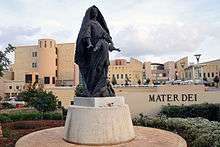Mater Dei Hospital
Mater Dei Hospital (MDH; Maltese: L-Isptar Mater Dei), also known simply as Mater Dei, is an acute general and teaching hospital in Msida, Malta. It is a public hospital affiliated to the University of Malta, offering hospital services and specialist services.
| Mater Dei Hospital | |
|---|---|
 | |
 The main entrance of Mater Dei Hospital | |

| |
| Geography | |
| Location | Msida, Malta |
| Organisation | |
| Type | General |
| Affiliated university | University of Malta |
| Services | |
| Emergency department | Yes |
| Beds | 1000 |
| History | |
| Opened | June 29, 2007 |
| Links | |
| Website | https://health.gov.mt/en/MDH/Pages/Home.aspx |
| Lists | Hospitals in Malta |
History
The hospital opened on 29 June 2007, replacing St. Luke's Hospital as the main public general hospital. The 250,000 square metre complex includes 825 beds and 25 operating theaters. It was built by Skanska Malta JV, a subsidiary of the Swedish construction firm Skanska. The project was planned to cost Lm 50,000,000 (around € 116,000,000), but rose to more than Lm 250,000,000 (around €582,000,000).
Skanska was entrusted with the building of a new general hospital in Malta, and the "state-of-the-art" Mater Dei Hospital cost over €700,000,000. Later, however, it was discovered that Skanska had used lower-quality cement of the kind that is generally used to build pavements. As a result, the hospital could not develop further floors or build a helipad on the roof.[1][2][3][4][5][6]
University of Malta affiliation
The hospital is located adjacent to the University of Malta, and contains the faculties of Health Sciences, Medicine and Surgery, and Dental Surgery in a purpose built Medical School wing. The hospital houses the Health Sciences Library which is a branch library of the University of Malta Library.
Sir Anthony Mamo Oncology Hospital
The Sir Anthony Mamo Oncology Hospital welcomed its first 50 outpatients on 22 December 2014. The hospital started being excavated in 2010 and building started in 2012. It cost €52 million and an estimated €8 million a year is required to run it. The hospital is offering more advanced radiotherapy with two machines commissioned from the Leeds Spencer Centre, where they were introduced in 2013. The machines enable more precise radiotherapy and stronger doses reducing the length and frequency of sessions. Considerations by the Maltese Government for expanding radiotherapy services to include autologous transplants have also been made. The government has also considered the development of a clinical trials unit through which Maltese patients would be able to benefit from new medicines not yet on the market. Beds at the new hospital increased from the 78 at Boffa Hospital to 113 and the outpatient clinics from two to 12. The type of chemotherapy provided is more advanced. A new MRI machine will help reduce waiting lists and palliative care beds were also increased from the 10 at Boffa to 16. Patients and their families would be followed before, during and after treatment and more training was being provided for staff. A total of 47 new professionals have been recruited on its opening day.[7]
Further reading
- Rudolf, Uwe James (2018). Historical dictionary of Malta (3 ed.). Lanham: Rowman & Littlefield. pp. 143, 144. ISBN 9781538119181. OCLC 1040078334.
See also
References
- Balzan, Saviour (21 September 2015). Skanska snubs government over hospital damage claims. Malta Today. Retrieved 1 July 2016.
- Waiver exonerated Skanska and Maltese partners on Mater Dei.
- PM orders investigation into Mater Dei concrete.
- Read: Hospital inquiry report, Arup report on Emergency Department.
- ARUP report. Volume 2.
- Inquiry report.
- Times of Malta. "Oncology Hospital welcomes first patients", Times of Malta, Malta, 22 December, 2015. Retrieved on 17 August 2015.